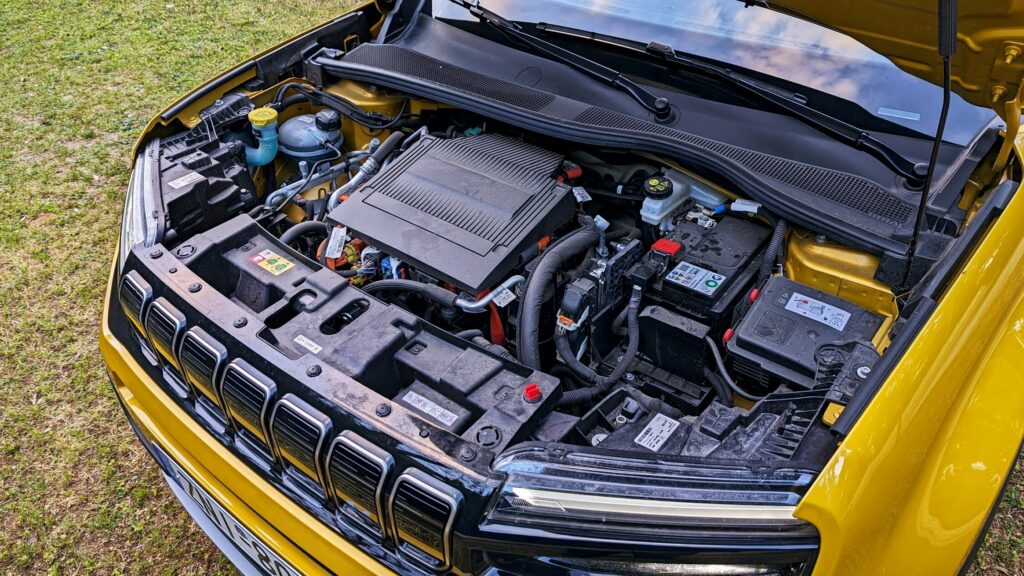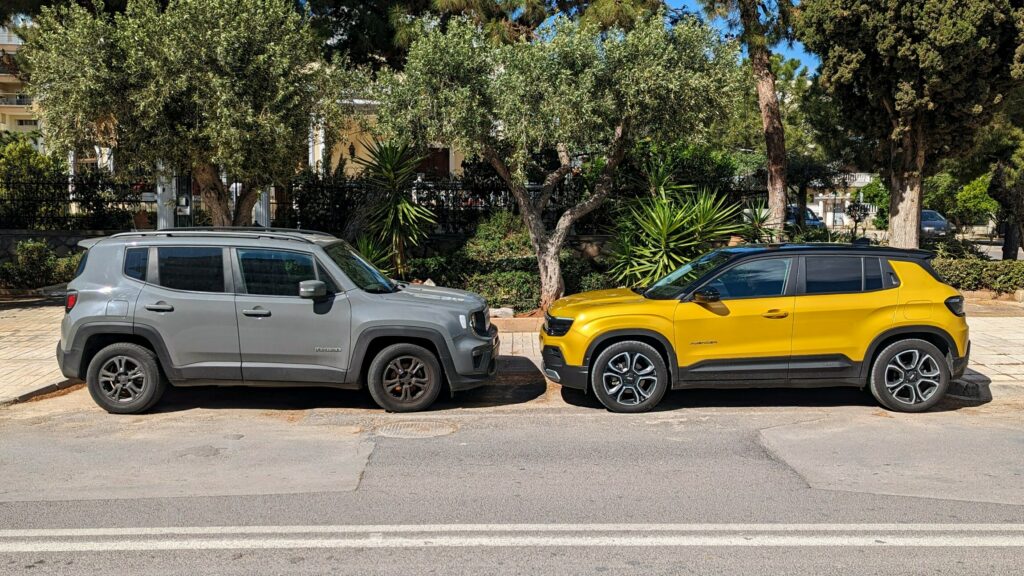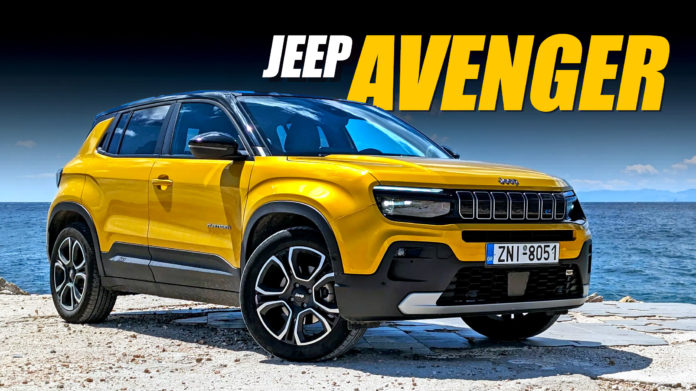As the pint-sized pioneer of Jeep’s European EV lineup, the Avenger faces a daunting challenge. It plunges headfirst into Europe’s fiercely competitive B-SUV (subcompact) segment, where established players and hungry newcomers vie for dominance.
We recently spent a week behind the wheel of the flagship Summit trim, putting the fully electric Avenger through its paces. Can this small electric SUV carve its own path in the crowded EV market?
Stylish And Compact
Our first impression upon seeing the Avenger is that it’s a neat-looking SUV. Jeep designers have done a great job applying the automaker’s styling language to a smaller body. The boxy silhouette, paired with heavily sculpted fenders and generous use of plastic cladding around the bodywork, gives it a rugged appearance, setting it apart from most of its competitors.
QUICK FACTS
Quirky details like the dark-tinted split LED headlights, X-shaped taillights, and a collection of “Easter eggs” – including the 7-slot grille emblem inside the grille and on the wheels – add a touch of playful charisma to the Avenger. Having said that, the optional Sun Yellow paint job and 18-inch alloy wheels on our press car elevate its aesthetics, as lower trims with smaller wheels and the standard colors lack the same visual pop.
The pint-sized Avenger isn’t just Jeep’s smallest offering, slotting in below the aging Renegade, but also one of the most diminutive players in the subcompact SUV segment. At a mere 4,084 millimeters (160.8 inches) long, it even undercuts its closely related cousins, the Fiat 500 and Alfa Romeo Tonale, by a noticeable 90 millimeters (3.5 inches).
Driven: Is The Alfa Romeo Tonale Hybrid Ti A Case Of Style Over Substance?
This means it can snug into the tight parking spaces of crowded European cities, much like a supermini, while also enjoying the added benefits of a raised body. Furthermore, Jeep-specific features such as shorter overhangs and a raised ground clearance of 200 mm (7.9 inches) enhance the Avenger’s off-road angles and proportions.
Surprisingly Practical
Moving inside, we’re greeted by a Wrangler-inspired body-colored dashboard and a modern digital cockpit. The standard 10.25-inch touchscreen is combined with a digital instrument cluster that measures 7 inches or, optionally, 10.25 inches, though it lacks the customization options found in some rivals. While the infotainment screen looks crisp and is easy to operate, the graphics appear dull.
Thankfully, Jeep designers included a row of physical button shortcuts on the center console, along with wireless Android Auto/Apple CarPlay compatibility, making everything easier for the driver. However, the downside is that the entire cabin is covered in hard plastics, with a noticeable lack of soft inserts that could enhance the perceived quality.
On the bright side, there is a surprising amount of in-car storage, totaling 34 liters (1.2 cubic feet) according to Jeep. The driver and front passenger have access to three large cubbies on the center tunnel, with the largest of them covered by a tablet-like folding magnetic cover. Additionally, there is a wide shelf across the width of the dashboard.
The door pockets are small and limited to the front occupants, and there are no climate vents for those at the back. Nevertheless, rear passengers will enjoy a decent amount of headroom and adequate legroom for the size of the vehicle. The narrow width of the cabin means there’s not enough space for a fifth passenger to sit comfortably between two adults at the rear bench, but that’s something common in the B-SUV segment. The boot is fairly large, with a capacity of 380 lt (13.4 cubic feet), a low floor and a squared-off shape.
Powertrain And Range
The Avenger was originally introduced in EV form in 2022, but the lineup has since expanded with the addition of ICE-only and mild-hybrid versions, covering a wider spectrum of the market. This was made possible thanks to the modularity of the CMP/e-CMP architecture that underpins a large number of Stellantis offerings and is used by the Avenger in its most evolved form. Our press car is fully electric, but we’ll soon get our hands on other powertrain variants to see how they compare.
The single front-mounted electric motor of the EV is good for up to 154 hp (115 kW / 156 PS) and 260 Nm (191.8 lb-ft) of torque. When in Sport mode, it offers a noticeable increase in acceleration, just don’t expect the kind of neck-snapping performance found in some larger EVs.
Review: The BYD Atto 3 EV Delivers Competence Without Revolution
In Normal mode, which is where we spent the majority of our time, the driving experience is suitable for daily use, with the output reduced to 107 hp (80 kW / 109 PS). For those concerned about range anxiety, there’s always the option to select Eco mode, which prioritizes efficiency but may result in a sluggish feel due to the reduced power output of 80 hp (60 kW / 82 PS). Fortunately, the driver has immediate access to the full power output by pressing the accelerator all the way to the floor.

From our experience, achieving the advertised WLTP range figure of 400 km (248 miles) is only possible when driving in the city at low speeds and prioritizing efficiency over performance. However, with mixed driving, we easily achieved a range of 330-340 km (205-211 miles) from the 54 kWh battery, which is decent enough for an urban SUV. One aspect I found lacking is the single available level of regenerative braking, which isn’t strong enough to match the one-pedal driving offered by many other EVs.
When plugged into a regular AC 11 kW charger, the battery takes 5.5 hours for a full charge, making it convenient for overnight charging or while at work. However, the Avenger is also compatible with 100 kW DC charging, allowing it to charge from 20 to 80 percent in just 24 minutes. This makes it ideal for when you’re in a hurry or planning longer trips on the highway.
Great Road Manners For A Jeep
Having driven most of the mechanically-related small SUVs from Stellantis, I was really impressed with the chassis setup of the Jeep Avenger. The ride is comfortable and refined, with excellent NVH credentials for the segment, making the EV delightfully quiet on the crowded roads of Athens, Greece. Despite the notable disadvantage of the 18-inch wheels found in the Summit trim over the 16-inch wheels of the entry-level Longitude, the suspension effectively softened the road imperfections
More: Jeep Avenger Gains Mild Hybrid Powertrain Option In Europe
At the same time, the car felt perfectly controllable when pushed, with fun-to-drive characteristics that I didn’t expect from a Jeep-branded product. Handling is really good with limited body roll and high levels of traction. The steering is a bit numb but gets heavier in the Sport mode, matching the extra power and the sharper accelerator response.
Compared to other models built on the same platform, the little Jeep feels more playful than the Peugeot e-2008, yet it’s also more comfortable and refined than the Opel Mokka Electric or the DS3 E-Tense. Its smaller size also makes it more agile in the city, with a smaller turning circle.
While I didn’t have the opportunity to test the more adventurous drive modes of Jeep’s Selec-Terrain system (Mud, Snow, and Sand) in their equivalent terrains, I must admit that I wouldn’t take the Avenger on challenging off-road courses. The SUV remains primarily road-focused, yet it’s willing to tackle driving on gravel and poor-quality roads, thanks to its Jeep-specific electronics and suspension setup
With shorter overhangs and higher ground clearance than the majority of its rivals, the Avenger can easily climb curbs and navigate speed bumps or steep ramps without concern. It remains to be seen if the upcoming mild-hybrid 4Xe version will infuse more off-road capability into the mix with its AWD capability. It’s also worth mentioning that the Summit trim comes standard with plenty of ADAS, which proved to be effective and easy to set up at all times.
Pricing And Rivals
In Greece, where we tested it, the fully electric Jeep Avenger starts from €38,977 ($41,982) before incentives, with the pictured Summit flagship trim increasing that number to €43,977 ($47,368). While this may seem like a significant investment for a small vehicle, a comparison with other fully electric subcompact SUVs in the same market reveals that the Avenger is competitively priced.

The slightly larger but mechanically identical Opel Mokka Electric starts from €40,500 ($43,590), and the Peugeot e-2008 from €42,000 ($45,205), both without considering local EV incentives, which can deduct around €8,000 ($8,610) from the list price. Other zero-emission rivals include the Fiat 500e, the larger and more practical Hyundai Kona Electric, and the upcoming Ford Puma Gen-E.
Review: 2024 Kia Niro EV GT-Line Is Expensive But Extremely Efficient
If you’re not committed to EVs, then the electric Avenger faces its strongest competition from within its own lineup. The ICE-powered version of the model is significantly cheaper, starting at €24,267 ($26,138), while the more efficient mild-hybrid starts at €26,767 ($28,831).
Verdict
The Jeep Avenger offers a compelling package to small SUV buyers who wish to stand out from the crowd in terms of styling and road presence, without sacrificing practicality. For a car with such a tiny footprint, the Avenger provides ample storage and can comfortably transport four adults. Moreover, the ride is surprisingly refined for the standards of the segment, making it comfortable for longer journeys, quiet and agile in the city, and fun-to-drive on twisty roads.
On the other hand, despite bearing the Jeep badge, the Avenger remains primarily focused on road driving, with its off-roading capabilities limited to well-paved gravel roads, despite featuring brand-specific drive modes and a rugged stance. Finally, the fully electric version delivers ample power for most drivers and offers decent range figures, especially in urban environments

